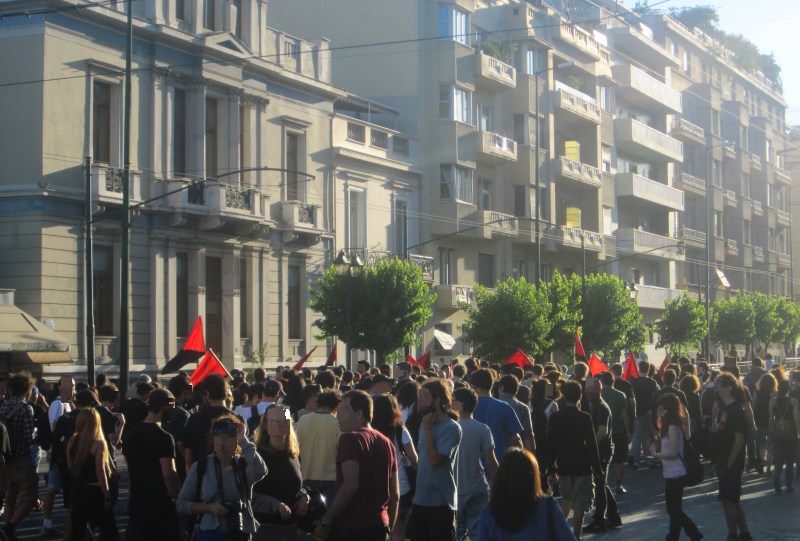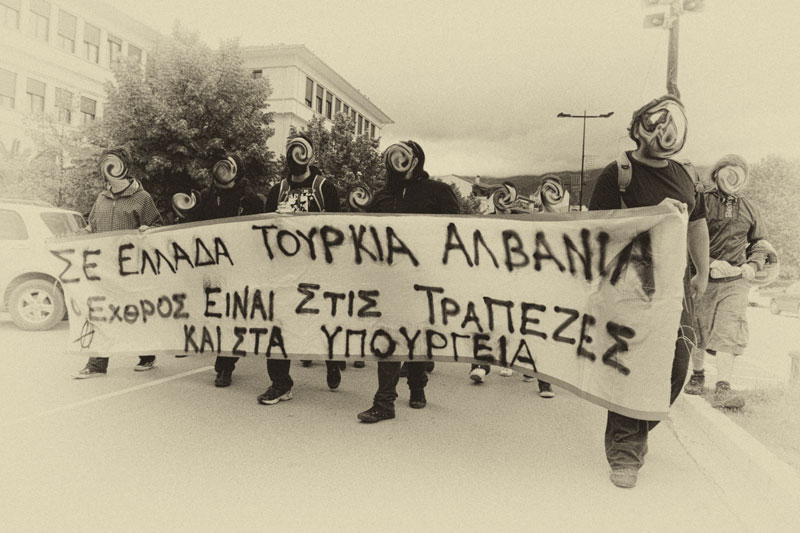Boston, Saturday, June 1—Braving temperatures well over ninety degrees, as many as 500 people gathered on the outer edge of the Boston Common Saturday, across the street from the Massachusetts Statehouse, to demonstrate their solidarity with the protests currently under police attack in Turkey.
Massed in a giant circle on the Common steps, the demonstrators weren’t there to address local politicians or passerby, so much as one another. A spirit of militant resistance was in the air, as attendees declared themselves on the side of those who, at that very moment, were facing down water cannons and tanks, tear gas and police batons in Turkey.
It was an impressive turnout for a rally called just the day before via Facebook. The initial call was put together by an improvised group calling themselves BostonBullular (a phrase meaning People of Boston in Turkish). It quickly took off with over 800 “joining” the event.
And most showed up.
The vast majority present appeared to be themselves from Turkey, and most were young, with few over forty in the crowd. Many said they had come to Boston from Turkey to study, whether as undergraduates or graduate students, in medicine, biology, engineering, or even business.
Though several of the organizers identified themselves as various stripes of socialist or communist, for most in attendance, this was their very first political demonstration, not just in the United States, but ever. The exuberance of the crowd suggested people not just opposing the governmental abuses of the moment, but affirming the newfound power of their own voice. There was outrage and sorrow, but also discovery and joy.
Many held aloft home-made signs, some painted in beautiful full color. Others wore Turkish flags as capes, or clasped strings attached to red and white balloons inscribed with the crescent and star of the national flag. The chanting was almost exclusively in Turkish, with only an occasional English refrain thrown in—“Hey hey! Ho ho! Tayyip Has Got to Go!” or “The People, United, will Never be Defeated!”—perhaps out of respect for the small but supportive non-Turkish allies.
The most frequent chant by far was for the resignation of Prime Minister Tayyip Erdogan, and for the dissolution of his Justice and Development Party (NKP) government, whom protesters hold responsible for the escalating police repression. Several people held signs mocking Tayyiq as a “Sultan” (playing off his recent calls for restoring the ‘glory’ of the Ottoman Empire in contemporary Turkey). Others denounced him as a “Dictator,” picturing him as a long-fanged vampire, or else encircled in red and crossed out. One protester likened him to “Hosni Mubarak #2,” conjuring the specter of not only another repressive ruler, but of a leader who, after having seemed untouchable for decades, fell from power rapidly in the face of popular uprisings.
Could Taksim Square be the new Tahrir? Could this be the start of a “Turkish Summer” to follow the “Arab Spring”?
In the shade of the towering, historic trees that line the Boston Common, new arrivals knelt to make signs from stacks of cardboard. The signs held high gave a sense of the grievances and aspirations of the demonstrators:
“Istanbul is not alone. We are with you!”
“Stop Police Brutality.”
“Fight Fascism Everywhere.”
“Democracy without freedom of expression is a joke.”
“Down with Sultan Tayyiq”
“Down with Dictatorship!”
“Shame on Turkish Media”
“RESISTANBUL.”
This last–and quite witty—phrase, which originated with the 2009 anti-capitalist protests against the International Monetary Fund meetings in Istanbul, has now become a Facebook page for those in solidarity with the revolt.
The nature of their protest occurring in a cherished Boston public park was not lost on organizers, several of whom held signs that said:
“Imagine if they demolished the Boston Common to build a shopping mall!”
This, after all, was what many saw Tayyip and his government as planning to do in Istanbul, by bulldozing the last remaining green spaces in Istanbul: Gezi Park. The main protest leaflet, under the title “RESISTANBUL” explained the connection further, outlining the origin of the uprising, and its significance. It was read aloud both in Turkish and in English mid-way through the rally:
“Since Monday, May 27th, 2013, citizens of Istanbul from all backgrounds have been staging a peaceful resistance in Gezi Park. Gezi Park is the city’s most central public park, comparable to Boston Common and Central Park in New York. The protestors’ goal was to protect the park, its trees, and landscape from a large project that would transform a public park into a shopping center. The demolition of the park should be recognized as yet another incident of the government’s ongoing appropriation and privatization of public and common resources with no respect for public opinion and judiciary process, and a lack of participatory democratic culture.”
[A video of the statement being read both in English and in Turksih can be found online at the “Bostonbullular” Facebook page.]
Of course, it was the police assault on Gezi Park and on the peaceful protesters there that set off the current uprisings across Istanbul, and across Turkey. As with the outbreak of the Occupy Wall Street movement in 2011, police brutality provoked widespread outrage, fanning rather than stamping out the flames of resistance. Images of Turkish police beating, gassing, severely injuring, and even killing protesters have gone viral across social media, in Turkey and beyond.
Protesters actively checked smart-phones throughout the rally, reading live social media posts from friends and family on the street in Istanbul and elsewhere. Some held signs with one hand while checking their phones with the other. There were reports of nearly 1000 protesters arrested, and of just as many seriously injured, including several who were in critical condition, and several actual deaths.
At one point the rally chants were interrupted by a man who quieted the crowd to ecstatically report that Tayyip Erdogan had resigned, provoking great cheers. The report was soon disproven, but was followed by more accurate and equally encouraging news: with hundreds of thousands of people now converging on Taksim Square and Gevi Park, the police had been ordered to retreat from the area. The mobilized people had held the park, saving their city’s green space, at least for the moment.
Online memes of trees growing into human fists and hands growing like trees proliferated, as Turkish artists and activists gave the uprising symbolic “roots” in the besieged park.
“They destroyed a tree and awoke a Nation!” One protest sign declared, painted in full color.
But the “Resistanbul” statement made clear that the attack on Gevi Park was not an isolated incident of police brutality, and that this movement has become about more than just defending a park. As they wrote:
“This is not the first time protests have been met with excessive state violence. Most recently, the Turkish police used unreasonable force to disperse May Day protestors again attacks a group of peaceful demonstrators in Istanbul’s Taksim Square. This disproportionate reaction and outrageous violence by the government against its own citizens cannot be justified in any way.”
Everyone I reached out to at the demonstration spoke quite fluent English, but Turkish remained the tongue for chanting. (I relied on a friend for rough translations):
“Tayyip Resign! Tayyip resign!”
“We Stand Shoulder to Shoulder, Against Fascism!”
“Taksim is everywhere. Resist Everywhere!”
As indicated in the statement above, by invoking Taksim, protesters connected with a spot which for years has served as a common rally point for marches and demonstrations in Istanbul, including annual May Day marches that often lead to violent clashes with police, who have attempted to suppress May Day marches since 1977. To call for Taksim everywhere, is thus effectively to challenge the state directly, that is, to call for revolution. Capturing the militancy of Taksim, other protest lyrics practically dared the government into confrontation with a defiant people. For instance, one song declared (translated):
“Bring on your gas. Bring on your gas. We won’t obey you any longer. Take off your mask, take off your mask. And we’ll see who is the stronger.”
This was no appeal to the “powers that be,” but a declaration of the people’s own power and daring.
The chants appeared to be among the very same that were being shouted in the streets of Turkey. Thus this demonstration, as one man told me, was less an appeal to US media or authorities than a virtual extension, a “microcosm,” of the protests there, a way to symbolically participate in the uprising. No doubt many photos and video-footage from the Boston rally would find their way home to those struggling on the streets of Istanbul, perhaps helping to spur them on.
Despite the police violence, people I spoke with indicated that if they were back home, they would most definitely be in the streets as well. Perhaps it was the Turkish street as much as anyone who was the intended audience of the rally.
Here in Boston however, the protest stayed in the park, retaining the form of a giant, close-knit human circle. People stood facing one another, together chanting and singing, clapping, pumping their fists, calling out to one another, to whoever was there to hear them.
**
Contrary to local Boston CBS coverage of the event, (available here: http://boston.cbslocal.com/2013/06/01/massachusetts-statehouse-demonstration-supports-turkish-protesters/ ) the primary focus of the protesters here was not just a secularist opposition to the religious aspects of the Islamic Justice and Development Party, but to a constellation of detested policies: related to economic development and foreign policy, as well as social and cultural matters.
Several protesters certainly expressed opposition to the government’s conservative social policies—which have included restrictions on consuming alcohol, and even bans on kissing in public. But just as important to people I spoke with was the government’s suppression of independent journalism and the shameful slavishness of a mainstream Turkish media that has been bought off or intimidated by the state. (Turkey currently imprisons more journalists than any country, with a constitution that makes “insulting the nation” a crime.) Similarly, several people I spoke with indicated outrage about the Turkish media showing “stupid” TV programs or features on “Miss Turkey” instead of covering the civil war that raged in the streets.
Just as crucial was many protesters’ sense that the entire city of Istanbul is being “sold off,” that their public property and common heritage is being privatized for the benefit of corporations, to appeal tourists, for the sake of “economic growth.” The threat to the trees of Gezi park—and to the forests that are threatened to be bulldozed if a new (third) bridge is built across the Bosphorus River—was seized upon by people as a metaphor for the common rights and the beauty that the current regime would strip away for the sake of its stubborn idea of “growth.”
Still others told me they object to Tayyip’s increasingly interventionist foreign policy, which they believe is making Turkey a junior partner to Western Imperialism across the Arab World. Several felt that this has had the effect of exacerbating ethnic and sectarian divisions within the country, while exposing Turks to potential violent retaliation. People I spoke with saw Tayyip’s close relationship with the US administration not as a solution, but as part of the problem, again likening him to the “new Hosni Mubarak” of the region. Others were concerned the US is getting Turkey to do its dirty work in the Syrian civil war.
All in all, despite rallying near the Statehouse, the sense on the Common was not of a group calling on others to do something so much as a community rallying itself for the task that must be done, for the struggle that only the people themselves can move forward.
Proposals to march on the Turkish consulate, located just down the street from the Common, were considered but apparently shelved. Instead, after more than an hour of rallying, protesters left the steps for the park, packing up signs, and gathering on the grass in the shade of the Common. There many stayed to take in a Turkish music concert and sing-along.
While some may have longed for a more militant and street-oriented march-action, the park sing-along was an appropriate finish. After all, the uprising in Turkey was kicked off by the defense of a public park. And even at that very moment, while street battles were raging across Turkey, hundreds of thousands of people gathered in Gezi Park were enjoying—for the moment—a victory and a much needed festival too, having successfully defended Taksim square from police and from privatization.
After an hour of shouting in the hot June sun, protesters in Boston soaked in the shade, the trees, the music, the soft grass, and each other’s companionship, these shared common things, the green roots from which raised fists grow.
Joe Ramsey is a writer, editor, scholar, and activist residing in the Boston area. He is co-editor of Cultural Logic: an electronic journal of marxist theory and practice www.clogic.eserver.org and a participant in the Kasama Projectwww.kasamaproject.org.



















